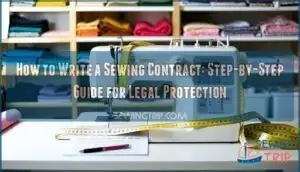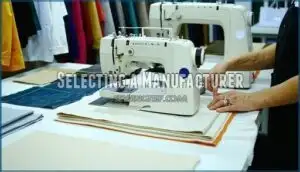This site is supported by our readers. We may earn a commission, at no cost to you, if you purchase through links.

Last year alone, small fashion businesses lost thousands to vague agreements and handshake deals that didn’t hold up when it mattered. Writing a sewing contract means thinking like a builder planning a house: every measurement, every promise, clear and in writing.
By nailing down your expectations from the first stitch, you protect your work and set the stage for a partnership that stands the test of time.
Table Of Contents
Key Takeaways
- A detailed tech pack with exact specifications, materials, and construction methods serves as your legal blueprint and prevents costly misunderstandings between you and your manufacturer.
- Clear payment terms—including deposit amounts, schedules, invoice due dates, and late fees—keep your financial relationship transparent and protect you from disputes.
- Liability protection through indemnity clauses, insurance requirements, and dispute resolution procedures shields you from unexpected legal and financial risks.
- Strong manufacturer relationships built on trust and open communication matter as much as the written contract itself, especially when resolving conflicts or managing production timelines.
Defining The Product
Before you can create a solid sewing contract, you need to get crystal clear about exactly what you want made. That means defining product specifications in practical, detailed terms—don’t leave anything to guesswork.
Start with a tech pack: outline visual specifications, measurements, and every material itemization. Call out the exact construction methods you expect, right down to seam types or thread choices if needed.
Specify your quality benchmarks up front, whether it’s the strength of a hem or the hand-feel of fabric. The more information you include, the safer both sides will be upon delivery. Think of it as making a blueprint for your product—each decision reduces misunderstandings and protects your project from start to finish.
Selecting a Manufacturer
Picking a manufacturer isn’t just about who knows their way around a sewing machine. You’ll want to run through a few key checks before you commit.
Here’s what to look for as you narrow down your options.
Price Confirmation and Quantities
Once you’re ready to negotiate, nailing down the right price and clarifying how many pieces you actually need will save you a world of trouble down the line. Ask for quoting prices on different quantities—sometimes tiered pricing brings quantity discounts.
Get everything in writing—payment terms, product specs, and delivery dates—before anyone drafts a contract. Sorting out these details upfront will save you from scrambling to fix problems later.
Tech Pack Expectations
Once you’ve settled on pricing and order volumes, it’s time to nail down your tech pack requirements. Modern manufacturing agreements depend on precise technical documentation—detailed measurements, material specifications, and finishing instructions all spelled out clearly.
When your specs are digitized and comprehensive, you’ll catch errors before they cost you money, tighten up production accuracy, and meet today’s sustainability expectations. A thorough tech pack can improve garment production quality. Think of it as your product’s binding contract with the factory.
Importance of Relationships
When you’ve done everything by the book on paper, how you connect and communicate with your manufacturer is still what makes the partnership work. Beyond any sewing contract or legal agreement, relationships are built through:
- Trust building over consistent, honest exchanges
- Open communication about timelines and expectations
- Conflict resolution—addressing issues early protects both your terms and conditions and customer satisfaction
Creating a Legal Contract
Once you’ve decided to draft a sewing contract, start with the fundamentals. Getting these details right safeguards both parties and sets clear expectations before any work begins.
Here are the main areas you should address.
Payment Terms
Nobody likes surprises with money—clear payment terms keep both you and your contractor on the same page from day one. Spell out payment schedules, deposit amounts, and which payment methods are accepted, whether wire transfer, PayPal, or another platform.
State when each invoice is due—Net 30, Net 60, or on delivery. Don’t forget to include late fees and how invoice disputes are handled.
A detailed section makes financial management easier, ensures prompt payments, and keeps your working relationship running smoothly.
Liability Protection
Protect yourself from unexpected costs by including liability protection in your sewing contracts. Add indemnity clauses to shift risks appropriately, and make sure contractors carry insurance that matches your project’s needs.
Set clear warranty disclaimers and compliance requirements from the start. Including straightforward dispute resolution methods—such as arbitration—can prevent headaches down the road.
Strong contractual indemnity brings peace of mind and real legal protection. Contractors should also understand industry norms to guarantee fair agreements.
Managing The Financials
Before any needles hit the fabric, it’s smart to make sure your payment process is straightforward and secure from day one. Outline payment schedules and deposit amounts in your contract so both sides know exactly when money changes hands.
Clear invoice management reduces confusion, while offering flexible customer payment methods—including digital options—builds trust. Consider financing options if larger orders stretch your client’s budget.
Use accounting software to track costs, payments, and the cost of goods sold, which keeps your business organized for tax season. Include refund policies in writing, leaving no guesswork if projects shift or stumble.
A little planning up front ensures you stay focused on sewing instead of chasing down payments later.
Ensuring Customer Satisfaction
Happy clients do more than make your day—they’re what keeps your sewing business running strong year after year. To keep satisfaction high, focus on:
- Clear communication to manage expectations and set the right tone in your sewing service contracts.
- Addressing concerns quickly, as outlined in your contract’s terms and conditions of service.
- Using feedback mechanisms and quality assurance to make certain each Sample Contract For Sewing Services builds lasting trust and loyalty.
Frequently Asked Questions (FAQs)
How do you write a contract?
The first step in writing any contract is finding a good template and getting clear on what you actually need.
Define key terms, include dispute resolution and termination conditions, and make sure there’s a clear offer, acceptance, and essential elements of a contract.
How to write a legal contract?
You’ll need clear agreement between parties and a few key elements to make a contract legally binding: an offer, acceptance, compliance with the law, and genuine intent to create obligations.
To create enforceable agreements, you’ll want to get familiar with contract law fundamentals, spell out every important detail, establish clear procedures for handling disputes and breaches, and have a lawyer review your work.
How do you write a legally binding contract?
A legally binding contract needs several key components: offer and acceptance, essential contractual elements, legal relations between parties, dispute resolution procedures, and termination clauses.
Make sure everything’s clearly defined and meets legal validity standards—and don’t hesitate to get legal advice when you’re putting it together.
Keep your writing clear, ensure it holds up legally, and get a lawyer’s input when you’re drafting a contract.
Can I write my own contract?
Yes, you can write your own contract using contract templates and careful research. Just remember, DIY risks include enforceability concerns—missing essential elements could cost you.
Legal advice helps make certain your sewing contract covers all requirements, protecting your interests.
How do you start a simple contract?
Before you sign anything, grab a simple contract template and customize it for your needs.
Clearly list all parties, define deliverables, establish payment, and include key terms plus basic dispute mechanisms for a secure agreement.
How do you write a web design contract?
Begin by drafting a contract that clearly outlines what you’ll deliver, how you’ll stay in touch with clients, and how many rounds of changes are included.
Spell out Website Ownership, Maintenance Agreements, liability protection, and payment terms—using legal forms or online tools for an easy, protective agreement.
What is the difference between a tech pack and a pattern?
A tech pack bundles every detail needed—design specifications, materials, and production communication—to nail your sewing contract, while a pattern is the hands-on blueprint for pattern creation, guiding the actual cutting and assembly process.
How do I ensure that the quality of the finished product is what I expect?
Imagine holding a garment that doesn’t match your vision—loose stitching, wrong fabric, misaligned seams.
You can avoid this by establishing quality benchmarks in your sample contract, including detailed specifications for material selection and construction methods.
Conduct inspection protocols before final acceptance, checking each piece against quality standards and your tech pack.
Include defect clauses that allow for alterations or rejection if quality control measures aren’t met.
What are the best practices for managing the financials of a sewing contract?
Collect a deposit upfront to cover materials and protect your time.
Use accounting software to track expenses and create professional invoices.
Establish clear payment terms and schedules, and consider online payment methods for faster processing.
How can I ensure that my customers are satisfied with their experience?
Respond quickly to questions and address concerns before they escalate. Clear communication about timelines and quality control builds trust with your clients.
Use feedback mechanisms to track customer satisfaction and strengthen relationships. Proper garment care instructions also manage expectations effectively.
Conclusion
Think of your contract as the frame that holds everything together: what you spell out now protects the work you’re about to deliver.
A sewing contract isn’t busywork—it’s what keeps you covered when timelines get messy or a client’s vision starts to drift.
Lock down your terms, spell out your standards, and you won’t just finish projects; you’ll finish them with confidence and your reputation intact. A solid contract turns uncertainty into clarity, one clause at a time.
A solid contract turns uncertainty into clarity, protecting your work and reputation one clause at a time










